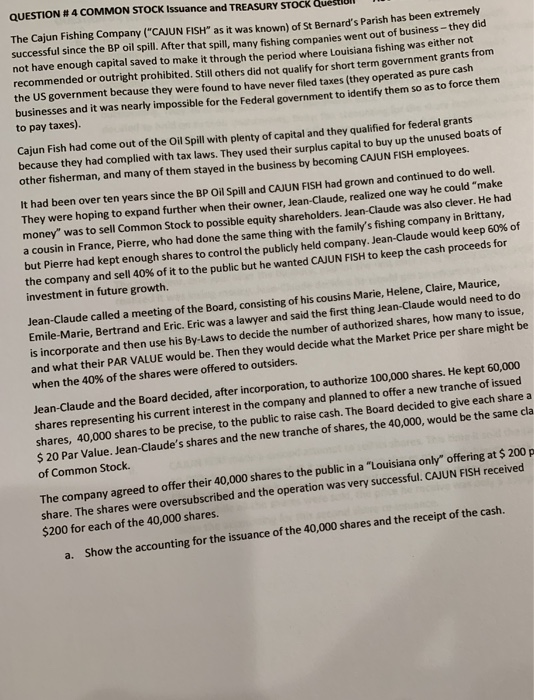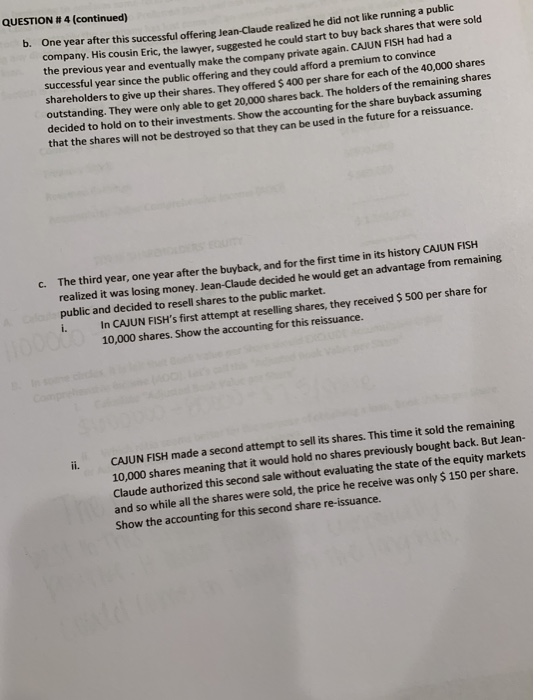OUESTION # 4 COMMON STOCK Issuance and TREASURY STOCK Q The Cajun Fishing Company ("CAJUN FISH" as it was known) of St Bernard's Parish has been extremely successful since the BP oil spill. After that spill, many fishing companies went out of business-they did not have enough capital saved to make it through the period where Louisiana fishing was either not recommended or outright prohibited. Still others did not qualify for short term government grants from the US government because they were found to have never filed taxes (they operated as pure casi businesses and it was nearly impossible for the Federal government to identify them so as to force them to pay taxes). Cajun Fish had come out of the Oil Spill with plenty of capital and they qualified for federal grants because they had complied with tax laws. They used their surplus capital to buy up the unused boats of other fisherman, and many of them stayed in the business by becoming CAJUN FISH employees. It had been over ten years since the BP Oil Spill and CAJUN FISH had grown and continued to do well. They were hoping to expand further when their owner, Jean-Claude, realized one way he could "make money" was to sell Common Stock to possible equity shareholders. Jean-Claude was also clever. He had a cousin in France, Pierre, who had done the same thing with the family's fishing company in Brittany, but Pierre had kept enough shares to control the publicly held company. Jean-Claude would keep 60 % of the company and sell 40% of it to the public but he wanted CAJUN FISH to keep the cash proceeds for investment in future growth. Jean-Claude called a meeting of the Board, consisting of his cousins Marie, Helene, Claire, Maurice, Emile-Marie, Bertrand and Eric. Eric was a lawyer and said the first thing Jean-Claude would need to do is incorporate and then use his By-Laws to decide the number of authorized shares, how many to issue, and what their PAR VALUE would be. Then they wou ld decide what the Market Price per share might be when the 40 % of the shares were offered to outsiders. Jean-Claude and the Board decided, after incorporation, to authorize 100,000 shares. He kept 60,000 shares representing his current interest in the company and planned to offer a new tranche of issued shares, 40,000 shares to be precise, to the public to raise cash. The Board decided to give each share a $20 Par Value. Jean-Claude's shares and the new tranche of shares, the 40,000, would be the same cla of Common Stock. The company agreed to offer their 40,000 shares to the public in a "Louisiana only" offering at $ 200 share. The shares were oversubscribed and the operation was very successful, CAJUN FISH received $200 for each of the 40,000 shares. a. Show the accounting for the issuance of the 40,000 shares and the receipt of the cash. QUESTION # 4 (continued) b. One year after this successful offering Jean-Claude realized he did not like running a public company. His cousin Eric, the lawyer, suggested he could start to buy back shares that were sold the previous year and eventually make the company private again. CAJUN FISH had had a successful year since the public offering and they could afford a premium to convince shareholders to give up their shares. They offered $ 400 per share for each of the 40,000 shares outstanding. They were only able to get 20,000 shares back. The holders of the remaining shares decided to hold on to their investments. Show the accounting for the share buyback assuming that the shares will not be destroyed so that they can be used in the future for a reissuance. The third year, one year after the buyback, and for the first time in its history CAJUN FISH realized it was losing money. Jean-Claude decided he would get an advantage from remaining c. oladpublic and decided to resell shares to the public market ooto In CAJUN FISH's first attempt at reselling shares, they received $ 500 per share for 10,000 shares. Show the accounting for this reissuance. i. Compre CAJUN FISH made a second attempt to sell its shares. This time it sold the remaining 10,000 shares meaning that it would hold no shares previously bought back. But Jean- Claude authorized this second sale without evaluating the state of the equity markets and so while all the shares were sold, the price he receive was only $ 150 per share. Show the accounting for this second share re-issuance. ii. # QUESTION TRUE or FALSE Preferred Stock can be a complicated security. With the right complications Preferred Stock can be either a Liability or an Equity item. A Company can only have one class of Common Stock. Dividends can be paid on both Common Stock and on Preferred Stock Non-controlling equity interests in a subsidiary are recorded in the Mezzanine section of the Balance Sheet. 1 2 3 4 When Dividends are paid in Cash, the impact of recording the Dividend 5 Declaration is to reduce the Retained Earnings account. If Dividends are Declared by not paid until some future date, the company records nothing on the Declaration date. In the traditional three steps for accounting for a Cash Dividend, there is no accounting entry on the Record Date if the Declaration Date precedes it and the Dividend Payment Date succeeds it. Book Value per share is a useless financial ratio because the Book Value must include the Accumulated Other Comprehensive Income account, which no one understands and even fewer people use. 6 7 8 A best practice is to record separate Additional Paid In Capital accounts separately for the various activities in Common Stock issuance, Treasury Share reissuance and other transactions that impact Equity accounts. Comprehensive Income is the same as Net Income, which is often labelled 10 Earnings. Nm YOUR QUESTION ANSWER The difference between the Market Price of Common Stock when capital is contributed and the PAR value of the Common Stock is Accumulated Other Comprehensive Income ("AOCI"). 1 a. Additional Paid In Capital ("APIC"). Retained Earnings b. c. A company wishes to accept land as an Equity Capital Contribution. The company is privately held, meaning is Common Stock is not traded in the market; no one knows how much its Common Stock is worth. The land is given a Fair Value by the Company's Controller. What is used as the measure, or amount, of the Contribution for accounting purposes: 2 The Fair Value of the Land. a. b. The Value of the Common Stock. c. The Collateral Value of the Land if used to obtain a mortgage. When a company is liquidated in Bankruptcy what happens to the investment of Preferred Stock investors: A. They receive a payout after debt capital claims are paid. B. They receive a payout before Common Stock holders do. C. A. and B Other Comprehensive Income is rolled up into the Account. 4 Earnings is rolled up into the Name a type of Contributed Capital Account: Name a type of Earned Capital Account: On occasion, such as the implementation of a new a "charge" or "expense" bypasses the Income Statement and is recorded directly as an adjusting entry to the Net Income is $ 10 million. The dividends declared for Preferred Stock is $2 million. What is the Net Income "attributable to the Common Stock Holders:" Account. 5 6 7 accounting standard, 8 Account. 9 a. $10 million. b. $2 million. c. $8 million. A balance in the Treasury Stock Account is recorded on the Left Hand or Debit side of Equity making it known as a 10 Equity Account. un 00 et










